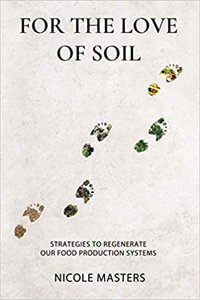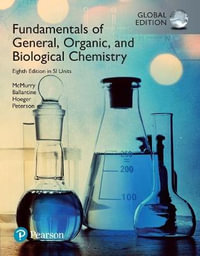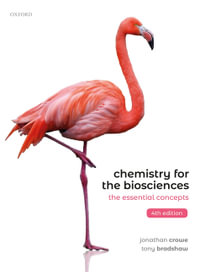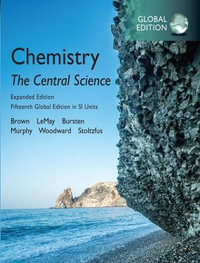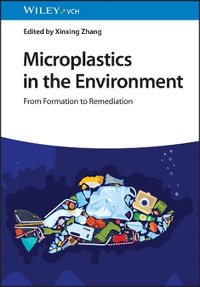
Aerosol Science
Technology and Applications
By: Ian Colbeck (Editor), Mihalis Lazaridis (Editor)
Hardcover | 14 January 2014 | Edition Number 1
At a Glance
496 Pages
25.01 x 17.09 x 2.96
Hardcover
RRP $322.25
$266.25
17%OFF
or 4 interest-free payments of $66.56 with
orAims to ship in 7 to 10 business days
AEROSOL SCIENCE
TECHNOLOGY AND APPLICATIONS
Aerosols influence many areas of our daily life. They are at the core of environmental problems such as global warming, photochemical smog and poor air quality. They can also have diverse effects on human health, where exposure occurs in both outdoor and indoor environments.
However, aerosols can have beneficial effects too; the delivery of drugs to the lungs, the delivery of fuels for combustion and the production of nanomaterials all rely on aerosols. Advances in particle measurement technologies have made it possible to take advantage of rapid changes in both particle size and concentration. Likewise, aerosols can now be produced in a controlled fashion. Reviewing many technological applications together with the current scientific status of aerosol modelling and measurements, this book includes:
- Satellite aerosol remote sensing
- The effects of aerosols on climate change
- Air pollution and health
- Pharmaceutical aerosols and pulmonary drug delivery
- Bioaerosols and hospital infections
- Particle emissions from vehicles
- The safety of emerging nanomaterials
- Radioactive aerosols: tracers of atmospheric processes
With the importance of this topic brought to the public's attention after the eruption of the Icelandic volcano Eyjafjallajoekull, this book provides a timely, concise and accessible overview of the many facets of aerosol science.
List of Contributors xiii
Preface xv
1. Introduction 1
Mihalis Lazaridis and Ian Colbeck
1.1 Introduction 1
1.2 Size and Shape 5
1.3 Size Distribution 6
1.4 Chemical Composition 10
1.5 Measurements and Sampling 11
References 12
2. Aerosol Dynamics 15
Mihalis Lazaridis and Yannis Drossinos
2.1 Introduction 15
2.2 General Dynamic Equation 17
2.2.1 Discrete Particle Size Distribution 18
2.2.2 Continuous Particle Size Distribution 19
2.3 Nucleation: New Particle Formation 19
2.3.1 Classical Nucleation Theory 20
2.3.2 Multicomponent Nucleation 22
2.3.3 Heterogeneous Nucleation 23
2.3.4 Atmospheric Nucleation 24
2.4 Growth by Condensation 26
2.5 Coagulation and Agglomeration 27
2.5.1 Brownian Coagulation 28
2.5.2 Agglomeration 28
2.6 Deposition Mechanisms 32
2.6.1 Stokes Law 32
2.6.2 Gravitational Settling 32
2.6.3 Deposition by Diffusion 34
2.6.4 Deposition by Impaction 34
2.6.5 Phoretic Effects 34
2.6.6 Atmospheric Aerosol Deposition 35
2.6.7 Deposition in the Human Respiratory Tract 36
2.7 Resuspension 38
2.7.1 Monolayer Resuspension 38
2.7.2 Multilayer Resuspension 39
References 41
3. Recommendations for Aerosol Sampling 45
Alfred Wiedensohler, Wolfram Birmili, Jean-Philippe Putaud, and John Ogren
3.1 Introduction 45
3.2 Guidelines for Standardized Aerosol Sampling 46
3.2.1 General Recommendations 46
3.2.2 Standardization of Aerosol Inlets 47
3.2.3 Humidity Control 49
3.3 Concrete Sampling Configurations 53
3.3.1 General Aspects of Particle Motion 53
3.3.2 Laminar Flow Sampling Configuration 54
3.3.3 Turbulent Flow Sampling Configuration 55
3.4 Artifact-Free Sampling for Organic Carbon Analysis 57
Acknowledgements 59
References 59
4. Aerosol Instrumentation 61
Da-Ren Chen and David Y. H. Pui
4.1 Introduction 61
4.2 General Strategy 62
4.3 Aerosol Sampling Inlets and Transport 63
4.4 Integral Moment Measurement 64
4.4.1 Total Number Concentration Measurement: Condensation Particle Counter (CPC) 65
4.4.2 Total Mass Concentration Measurement: Quartz-Crystal Microbalance (QCM) and Tapered-Element Oscillating Microbalance (TEOM) 66
4.4.3 Light-Scattering Photometers and Nephelometers 67
4.5 Particle Surface Area Measurement 68
4.6 Size-Distribution Measurement 70
4.6.1 Techniques based on Particle–Light Interaction 70
4.6.2 Techniques based on Particle Inertia 71
4.6.3 Techniques based on Particle Electrical Mobility 74
4.6.4 Techniques based on Particle Diffusion 77
4.7 Chemical Composition Measurement 78
4.8 Conclusion 80
References 82
5. Filtration Mechanisms 89
Sarah Dunnett
5.1 Introduction 89
5.2 Deposition Mechanisms 91
5.2.1 Flow Models 92
5.2.2 Diffusional Deposition 96
5.2.3 Deposition by Interception 98
5.2.4 Deposition due to Inertial Impaction 99
5.2.5 Gravitational Deposition 100
5.2.6 Electrostatic Deposition 100
5.3 Factors Affecting Efficiency 104
5.3.1 Particle Rebound 104
5.3.2 Particle Loading 106
5.4 Filter Randomness 109
5.5 Applications 109
5.6 Conclusions 110
Nomenclature 110
References 113
6. Remote Sensing of Atmospheric Aerosols 119
Sagnik Dey and Sachchida Nand Tripathi
6.1 Introduction 119
6.2 Surface-Based Remote Sensing 120
6.2.1 Passive Remote Sensing 120
6.2.2 Active Remote Sensing 126
6.3 Satellite-Based Remote Sensing 126
6.3.1 Passive Remote Sensing 127
6.3.2 Active Spaceborne Lidar 135
6.3.3 Applications of Satellite-Based Aerosol Products 136
6.4 Summary and Future Requirements 141
Acknowledgements 142
References 142
7. Atmospheric Particle Nucleation 153
Mikko Sipila, Katrianne Lehtipalo, and Markku Kulmala
7.1 General Relevance 153
7.2 Detection of Atmospheric Nanoparticles 156
7.2.1 Condensation Particle Counting 156
7.2.2 Electrostatic Methods 158
7.2.3 Mass Spectrometric Methods for Cluster Detection 160
7.3 Atmospheric Observations of New Particle Formation 163
7.3.1 Nucleation 163
7.3.2 Growth 165
7.4 Laboratory Experiments 166
7.4.1 Sulfuric Acid Nucleation 166
7.4.2 Hunt for Compound X 168
7.5 Concluding Remarks and Future Challenges 169
References 170
8. Atmospheric Aerosols and Climate Impacts 181
Maria Kanakidou
8.1 Introduction 181
8.2 Global Aerosol Distributions 181
8.3 Aerosol Climate Impacts 182
8.4 Simulations of Global Aerosol Distributions 186
8.5 Extinction of Radiation by Aerosols (Direct Effect) 190
8.5.1 Aerosol Optical Depth and Direct Radiative Forcing of Aerosol Components 193
8.6 Aerosols and Clouds (Indirect Effect) 194
8.6.1 How Aerosols Become CCNs and Grow into Cloud Droplets 195
8.7 Radiative Forcing Estimates 200
8.8 The Way Forward 203
References 203
9. Air Pollution and Health and the Role of Aerosols 207
Pat Goodman and Otto Hanninen
9.1 Background 207
9.2 Size Fractions 208
9.3 Which Pollution Particle Sizes Are Important? 209
9.4 What Health Outcomes Are Associated with Exposure to Air Pollution? 209
9.5 Sources of Atmospheric Aerosols 210
9.6 Particle Deposition in the Lungs 210
9.7 Aerosol Interaction Mechanisms in the Human Body 211
9.8 Human Respiratory Outcomes and Aerosol Exposure 215
9.9 Cardiovascular Outcomes and Aerosol Exposure 215
9.10 Conclusions and Recommendations 216
References 216
10. Pharmaceutical Aerosols and Pulmonary Drug Delivery 221
Darragh Murnane, Victoria Hutter, and Marie Harang
10.1 Introduction 221
10.2 Pharmaceutical Aerosols in Disease Treatment 223
10.2.1 Asthma 223
10.2.2 Chronic Obstructive Pulmonary Disease 224
10.2.3 Cystic Fibrosis 224
10.2.4 Respiratory Tract Infection 225
10.2.5 Beyond the Lung: Systemic Drug Delivery 225
10.3 Aerosol Physicochemical Properties of Importance in Lung Deposition 226
10.4 The Fate of Inhaled Aerosol Particles in the Lung 228
10.4.1 Paracellular Transport 229
10.4.2 Transcellular Transport 229
10.4.3 Carrier-Mediated Transport 230
10.4.4 Models for Determining the Fate of Inhaled Aerosols 231
10.5 Production of Inhalable Particles 233
10.5.1 Particle Attrition and Milling 233
10.5.2 Constructive Particle Production 235
10.6 Aerosol Generation and Delivery Systems for Pulmonary Therapy 237
10.6.1 Nebulised Disease Therapies 237
10.6.2 Pressurised Metered-Dose Inhaler Systems 241
10.6.3 Dry-Powder Inhalation 248
10.6.4 Advancing Drug-Delivery Strategies 252
10.7 Product Performance Testing 253
10.7.1 Total-Emitted-Dose Testing 253
10.7.2 Aerodynamic Particle Size Determination: Inertial Impaction Analysis 253
10.8 Conclusion and Outlook 255
References 255
11. Bioaerosols and Hospital Infections 271
Ka man Lai, Zaheer Ahmad Nasir, and Jonathon Taylor
11.1 The Importance of Bioaerosols and Infections 271
11.2 Bioaerosol-Related Infections in Hospitals 272
11.3 Bioaerosol Properties and Deposition in Human Respiratory Systems 275
11.4 Chain of Infection and Infection Control in Hospitals 275
11.5 Application of Aerosol Science and Technology in Infection Control 277
11.5.1 Understanding Hospital Aerobiology and Infection Control 277
11.5.2 Bioaerosol Experiments and Models 280
11.5.3 Numerical Analysis of Particle Dispersion in Hospitals 281
11.5.4 Air-Cleaning Technologies 282
11.6 Conclusion 285
References 285
12. Nanostructured Material Synthesis in the Gas Phase 291
Peter V. Pikhitsa and Mansoo Choi
12.1 Introduction 291
12.2 Aerosol-Based Synthesis 292
12.3 Flame Synthesis 292
12.4 Flame and Laser Synthesis 299
12.5 Laser-Induced Synthesis 302
12.6 Metal-Powder Combustion 309
12.7 Spark Discharge 313
12.8 Assembling Useful Nanostructures 314
12.9 Conclusions 322
References 323
13. The Safety of Emerging Inorganic and Carbon Nanomaterials 327
L. Reijnders
13.1 Introduction 327
13.2 Human Health and Inhaled Persistent Engineered Inorganic and Carbon Nanomaterials 330
13.3 Human Health Hazards and Risks Linked to the Ingestion of Persistent Inorganic Nanomaterials 333
13.4 Ecotoxicity of Persistent Inorganic and Carbon Nanomaterials 335
13.5 Conclusion 336
References 336
14. Environmental Health in Built Environments 345
Zaheer Ahmad Nasir
14.1 Environmental Hazards and Built Environments 345
14.2 Particulate Contaminants 348
14.2.1 Transport and Behaviour of Particles in Built Environments 349
14.3 Gas Contaminants 351
14.3.1 Biological Hazards 351
14.3.2 Physical Hazards 357
14.3.3 Ergonomic Hazards 358
14.3.4 Ventilation and Environmental Hazards 359
14.3.5 Energy-Efficient Built Environments, Climate Change and Environmental Health 361
References 362
15. Particle Emissions from Vehicles 369
Jonathan Symonds
15.1 Introduction 369
15.2 Engine Concepts and Technologies 370
15.2.1 Air–Fuel Mixture 370
15.2.2 Spark-Ignition Engines 371
15.2.3 Compression-Ignition Engines 372
15.2.4 Two-Stroke Engines 372
15.2.5 Gas-Turbine Engines 373
15.3 Particle Formation 373
15.3.1 In-Cylinder Formation 373
15.3.2 Evolution in the Exhaust and Aftertreatment Systems 375
15.3.3 Noncombustion Particle Sources 375
15.3.4 Evolution in the Environment 376
15.4 Impact of Vehicle Particle Emissions 376
15.4.1 Health and Environmental Effects 376
15.4.2 Legislation 376
15.5 Sampling and Measurement Techniques 378
15.5.1 Sample Handling 378
15.5.2 Mass Measurement 379
15.5.3 Solid-Particle-Number Measurement 380
15.5.4 Sizing Techniques 382
15.5.5 Morphology Determination 382
15.6 Amelioration Techniques 385
15.6.1 Fuel Composition 385
15.6.2 Control by Engine Design and Calibration 385
15.6.3 Particulate Filters 386
Acknowledgements 388
References 388
16. Movement of Bioaerosols in the Atmosphere and the Consequences for Climate and Microbial Evolution 393
Cindy E. Morris, Christel Leyronas, and Philippe C. Nicot
16.1 Introduction 393
16.2 Emission: Launch into the Atmosphere 395
16.2.1 Active Release 397
16.2.2 Passive Release 397
16.2.3 Quantifying Emissions 398
16.3 Transport in the Earth’s Boundary Layer 399
16.3.1 Motors of Transport 399
16.3.2 Quantifying Near-Surface Flux 400
16.4 Long-Distance Transport: From the Boundary Layer into the Free Troposphere 404
16.4.1 Scale of Horizontal Long-Distance Transport 404
16.4.2 Altitude of Long-Distance Transport 405
16.5 Interaction of Microbial Aerosols with Atmospheric Processes 406
16.6 Implications of Aerial Transport for Microbial Evolutionary History 407
References 410
17. Disinfection of Airborne Organisms by Ultraviolet-C Radiation and Sunlight 417
Jana S. Kesavan and Jose-Luis Sagripanti
17.1 Introduction 417
17.2 UV Radiation 418
17.3 Sunlight 419
17.4 Selected Organisms 421
17.4.1 Bacterial Endospores 421
17.4.2 Vegetative Bacteria 422
17.4.3 Viruses 423
17.5 Effects of UV Light on Aerosolized Organisms 423
17.5.1 Cell Damage Caused By UV Radiation 423
17.5.2 Photorepair 424
17.5.3 Typical Survival Curve for UV Exposure 425
17.5.4 The UV Rate Constant 427
17.5.5 RH and Temperature Effects 428
17.5.6 Bacterial Clusters 429
17.6 Disinfection of Rooms Using UV-C Radiation 429
17.7 Sunlight Exposure Studies 430
17.8 Testing Considerations 431
17.8.1 Test Methodology in Our Laboratory 432
17.9 Discussion 435
References 435
18. Radioactive Aerosols: Tracers of Atmospheric Processes 441
Katsumi Hirose
18.1 Introduction 441
18.2 Origin of Radioactive Aerosols 442
18.2.1 Natural Radionuclides 442
18.2.2 Anthropogenic Radionuclides 444
18.3 Tracers of Atmospheric Processes 446
18.3.1 Transport of Radioactive Aerosols 446
18.3.2 Dry Deposition 448
18.3.3 Wet Deposition 449
18.3.4 Resuspension 450
18.3.5 Other Processes 452
18.3.6 Application of Multitracers 452
18.3.7 Atmospheric Residence Time of Radioactive Aerosols 454
18.4 Tracer of Environmental Change 457
18.5 Conclusion 460
References 461
Index 469
ISBN: 9781119977926
ISBN-10: 1119977924
Published: 14th January 2014
Format: Hardcover
Language: English
Number of Pages: 496
Audience: Professional and Scholarly
Publisher: John Wiley & Sons (UK)
Country of Publication: US
Edition Number: 1
Dimensions (cm): 25.01 x 17.09 x 2.96
Weight (kg): 0.98
Shipping
| Standard Shipping | Express Shipping | |
|---|---|---|
| Metro postcodes: | $9.99 | $14.95 |
| Regional postcodes: | $9.99 | $14.95 |
| Rural postcodes: | $9.99 | $14.95 |
How to return your order
At Booktopia, we offer hassle-free returns in accordance with our returns policy. If you wish to return an item, please get in touch with Booktopia Customer Care.
Additional postage charges may be applicable.
Defective items
If there is a problem with any of the items received for your order then the Booktopia Customer Care team is ready to assist you.
For more info please visit our Help Centre.
You Can Find This Book In

The Wiley Guide to Strategies, Ideas, and Applications for Implementing a Total Worker Health Program
Paperback
RRP $173.75
$149.50
OFF

Cholesterol, Lipoproteins, and Cardiovascular Health
Separating the Good (HDL), the Bad (LDL), and the Remnant
Hardcover
RRP $207.95
$124.75
OFF





